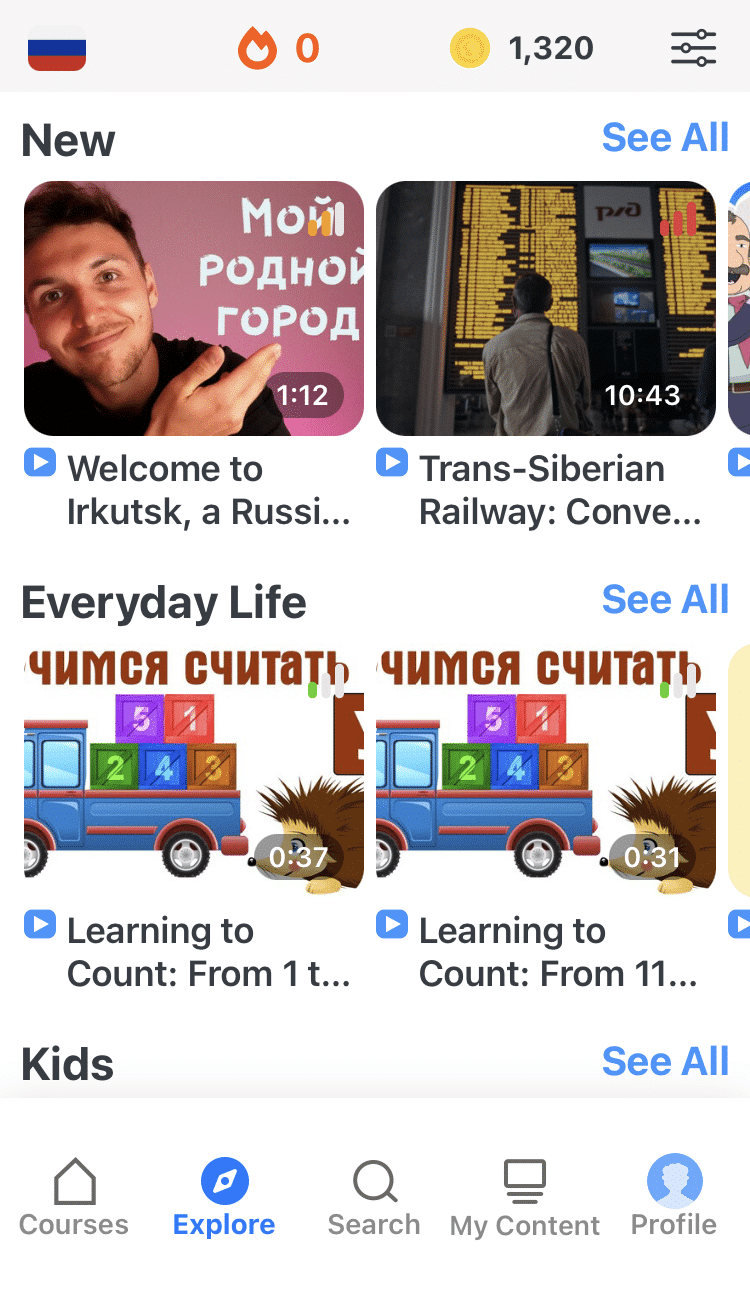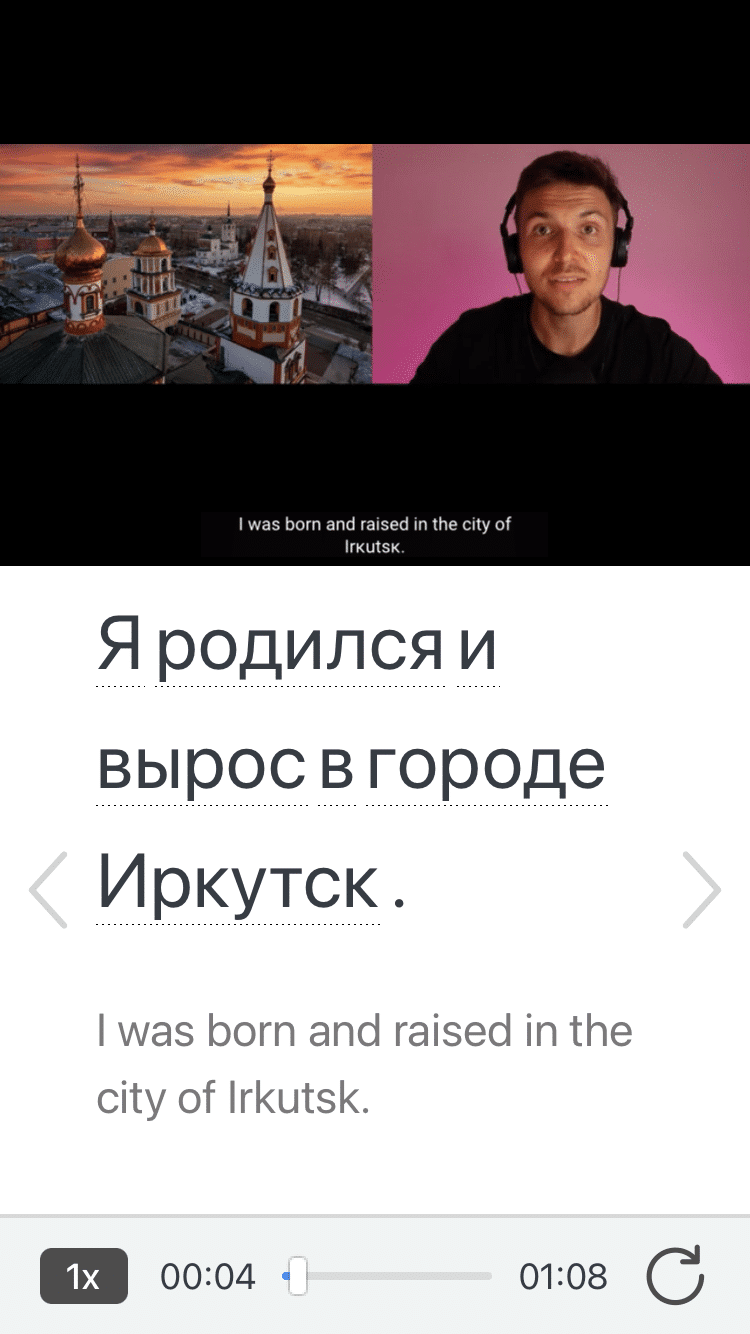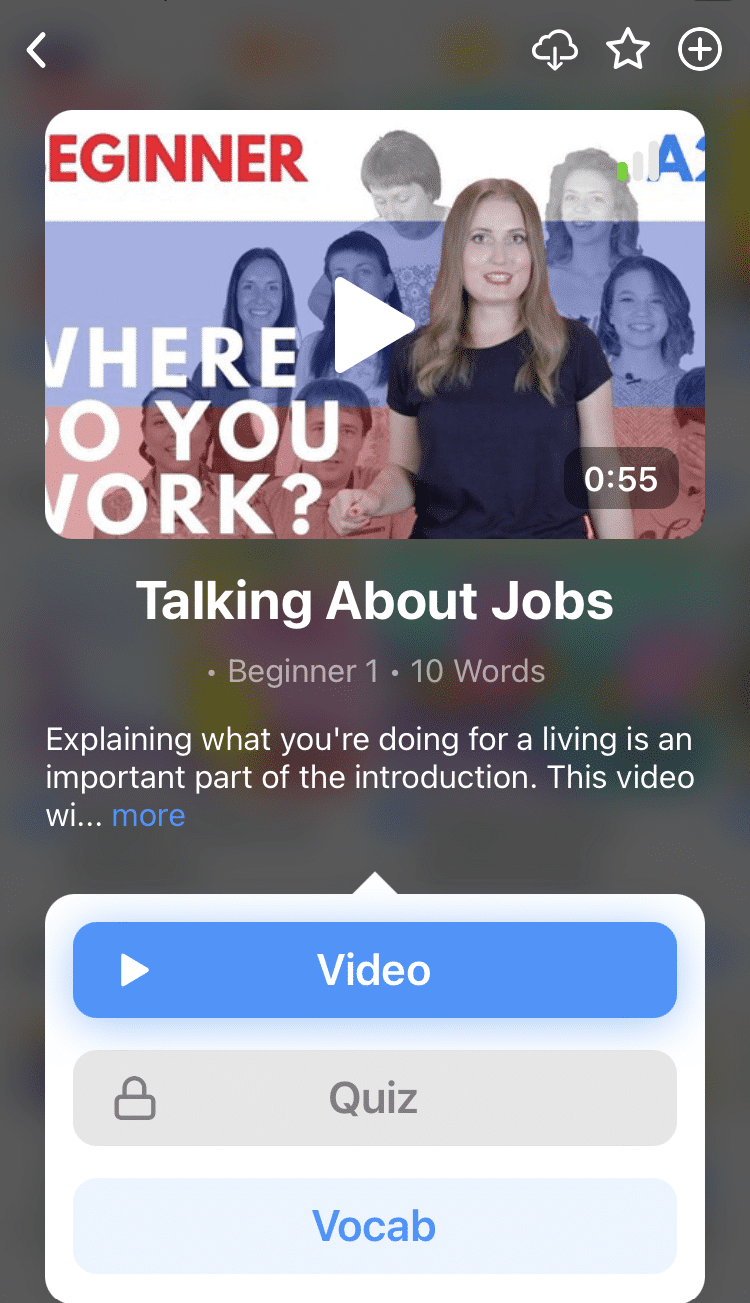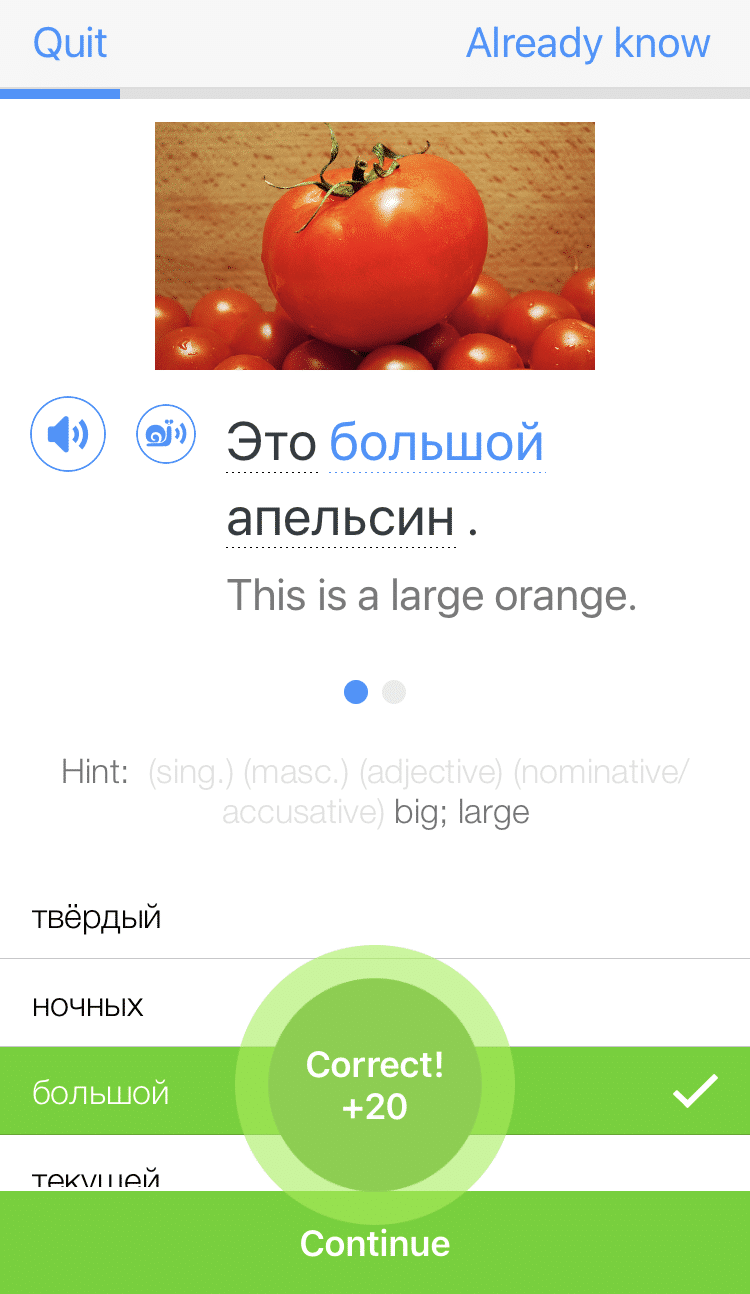
How to Learn Russian with Subtitles (and Where to Find Subtitled Videos)
Many streaming services, such as Netflix, have movies and TV shows with Russian subtitles. This means you can turn your movie nights into learning sessions by using the smart viewing strategies described in this post.
Watch content in English or Russian with subtitles in either language to reap the benefits of learning Russian with subtitles. I’ll even throw in a couple of places where you can (legally) find Russian subtitles.
Contents
- 1. Before You Watch Russian Videos
- 2. While You Watch Russian Videos
- 3. After You Watch Russian Videos
- Where to Find Content with Russian Subtitles
- How to Add Russian Subtitles to English Content
- Can You Learn Russian with Subtitles?
Download: This blog post is available as a convenient and portable PDF that you can take anywhere. Click here to get a copy. (Download)
1. Before You Watch Russian Videos
Warm up with other study methods
To make the most of your viewing session, plan a review before you watch. Warm up by running through some flashcards or listening to a song. It’s also helpful to review the vocabulary and grammar concepts that you learned in your last study session. By doing this, you’re priming your brain to be on the lookout for authentic instances of the things you’re currently learning.
Have a plan
Every Russian video contains a plethora of things to learn. Having a plan helps you narrow your focus to a specific goal. Ask yourself:
- What language skills do I want to practice?
- What vocabulary or grammar do I want to keep an eye out for?
- What do I want to learn from this play-through?
Zero in on your main goal and keep it in mind as you watch. It can help to write down your goal and a few questions before you start. This strategy also enables you to re-watch the same video multiple times and learn something new from it each time.
Improve reading fluency
Russian subtitles can flash by pretty quickly, so it’s easy to get left behind. Work on improving your reading speed before you dive into videos subtitled in Russian. You can start with easy reading practice videos like this one from Russian Level 1.
Use videos like this for Russian shadowing practice, where you read and speak along with the video. Regular reading practice is also helpful—you can bump up the challenge by timing how long it takes you to read a passage, then setting a timer for a minute or two faster than you’re comfortable with.
Until you feel ready to tackle reading Russian subtitles quickly, you can stick to using English or dual-language subtitles for practice.
2. While You Watch Russian Videos
Take notes
Always have a notebook handy for note-taking. I use the word “notebook” loosely since you can use anything from a literal pen and paper, a digital note-taking app on your phone or even just a Word document on your computer (after all, ноутбук means “laptop” in Russian!).
There are several ways to take notes when studying with subtitled Russian videos:
- Keep a running list of vocabulary and phrases that you like or that are new to you. It’s always useful to include the full sentence where you find new vocab, for context.
- Write down pre-watching questions and answer them as you watch. You can base your questions on vocabulary or grammar that you’re currently studying, or to test your listening and reading comprehension. This resource for grade-school students has 70 higher-order thinking questions that you can borrow for your Russian studies. They’re especially useful for getting you to think about what you’re watching. Challenge yourself to answer them in Russian!
- Focus on a short scene. Write down the whole dialogue, either from the subtitles or by listening to the video. You can use this written passage in your studies later—try translating it or performing it out loud to practice your pronunciation.
Listen first, then read
The human brain is not very good at multitasking. Improve your chances of understanding the video by splitting the tasks in half: The first time you watch the video, turn off the subtitles and use your ears only. Then, play the video back again with the subtitles and focus on reading along.
If you’re watching with English subtitles, resist the instinct to simply read everything. Instead use the subtitles as a backup to confirm your understanding.
Pay attention to translation choices
If you’re watching with English audio and Russian subtitles or vice versa, note how the translators chose to translate certain words. Pay especially close attention to translations of idioms and slang. This will give you clues on how Russian speakers might naturally speak in the given situation.
Note that not all subtitles are well translated—even if they were “professionally” done. You should be especially wary of subtitle files downloaded online, which may be independently created and inaccurate. When studying the translations, try to cross-check with research online.
A good exercise to try is to choose a sentence or a scene and try to translate it yourself. When you’re satisfied with your translation, compare it to the “official” translation. You can also ask a native Russian speaker for a second opinion, whether you ask a Russian-speaking friend or a kind stranger on a website like HiNative.
Watch on mute
You can practice your reading skills by watching a video on mute with Russian subtitles on. Replay scenes as often as you need and try to keep up with the Russian script.
Flip the exercise and practice your Russian speaking skills by playing a Russian video with English subtitles on mute. Read the English subtitles and try to say the Russian version out loud. This exercise is especially difficult because it requires you to think in Russian and translate entire thoughts into the language. Try to keep up!
Listen for intonation and tone
Match up the words on the screen to how they’re actually spoken. What intonation patterns do you notice? Which words are stressed? Which are so unstressed they’re almost swallowed? Honing in on these details will sharpen your ear for authentic Russian conversation.
3. After You Watch Russian Videos
Do follow-up activities
Your learning doesn’t end when the credits roll. After the video is over, take your notebook and continue working. Here are a few helpful follow-up activities you can do with nearly any video:
- If you’ve been keeping a list of new vocabulary words and phrases, now is the time to look them up. Don’t stop at simply finding a definition. Google the word or phrase to find more context online. Is it slang or formal language? Does it have a positive or negative connotation—or both, depending on the situation? After your research, make a special flashcard deck to quiz yourself later.
- Choose a handful of questions to answer from this massive list of follow-up movie questions from Teach with Movies. Once again, challenge yourself to answer the questions in Russian, either spoken or written.
- Summarize what you just watched. This is one of the simplest and most effective ways to make sure you understood what you just watched. If you’re finding it hard to summarize the video, this might be a sign that you need to rewatch it again.
- If your Russian is at a more advanced level, you can really get creative with your follow-up activities. If you watched a movie, for example, you can try writing an alternate ending or a dialogue between two characters after the movie’s end. Try telling the story from a different point of view, or write a newspaper article about something that happens in the video. Choose a character and write a blog from their point of view or a text exchange between two characters. Anything goes, so have fun with it!
Watch it again
The first time you watch a video in Russian (especially a film or ongoing TV series), it’s easy to get lost in the storyline and turn your attention away from the language. This is a good sign since it means you chose something that you’re actually interested in. But if you’re going to be using this video for language learning, then you’ll need to watch it several times.
The first time, just enjoy the experience. The second time, dig deeper into the language without getting distracted by the unfolding story. Once you have a good idea of what the video is about, challenge yourself to watch it again, without subtitles. Go back to the “have a plan” step each time, and focus on a different aspect of the video. Each piece of Russian media is a goldmine, so make full use of it!
Where to Find Content with Russian Subtitles
A lot of media with Russian subtitles available on the internet isn’t strictly legal. Luckily, there are quite a few legit ways to watch videos with Russian subtitles (as well as Russian content with English subtitles).
Online streaming services
Many popular streaming services have content with Russian subtitles. Netflix, for instance, allows you to browse for content that has Russian subtitles and videos that are dubbed in Russian. You can also find Russian movies and TV shows on iTunes and Google Play (though you might have to search for specific movies by name here, like this listing for “Brother”).
FluentU
Plus, the videos are all naturally entertaining since they come from the shows, movies and channels that native Russian-speakers enjoy on the regular. You can watch documentary footage, television show clips, funny commericals and more all while learning the Russian language!
Take a quick look at what FluentU has on offer for yourself:

Didn't catch something? Go back and listen again. Missed a word? FluentU makes native Russian videos approachable through interactive captions. Tap or click on any word to see a definition, in-context usage examples, audio pronunciation, helpful images and more.

Access a complete interactive transcript of every video under the Dialogue tab. Easily review words and phrases with audio under Vocab.

Don’t stop there, though! Use FluentU’s quizzes to actively practice all the vocabulary in any video. Swipe left or right to see more examples of the word you're on.

And FluentU always keeps track of vocabulary that you’re learning. It uses that information to give you a 100% personalized experience by recommending videos and examples.
Start using the FluentU website on your computer or tablet or, better yet, download the FluentU app from the iTunes or Google Play store. Click here to take advantage of our current sale! (Expires at the end of this month.)
Physical DVDs and Blu-ray
This option may be a little expensive, but it’s worth it if you want a wider range of options and no chance of the content disappearing from your favorite streaming service. Keep in mind that not all Russian movies come with Russian subtitles!
Russian YouTube
Several classic old movies are also available on YouTube for free, though the subtitles are usually in English and their quality is hit or miss. To get started, check out the 1967 two-part film “Anna Karenina” (a personal favorite) or the subtitled collections on the Mosfilm channel (which include the comedies “Ivan Vassilyevich Changes Occupation” and “Afonya”). Many Russian cartoons are also available with subtitles.
Lower levels will also be happy to know there’s a series of animated children’s books in Russian on the Book Box channel. I recommend “The First Well” and “The Little Pianist.” (All super cute.)
Russian YouTubers and vloggers also often subtitle their videos, if you’re looking for something more authentic. When no official subtitles are available, YouTube’s closed captioning is a decent option (but, of course, not always accurate). Two well-known vloggers to start with are Kate Clapp, who does chatty lifestyle and travel videos, and Adam Thomas Moran, whose videos are more like a visual podcast. Be forewarned that both speak very quickly!
How to Add Russian Subtitles to English Content
Say you want to watch your favorite English-language TV show or YouTuber with Russian subtitles, but there isn’t an option to do so. There are several solutions available that allow you to add subtitles to English-language videos:
- Download subtitle files online. There are a number of websites where you can find subtitle files in Russian for English content. These generally come as .srt files and you can use a program like Clideo or a tutorial to add the subtitles to the video you’re watching. I won’t link to the specific subtitle file websites as the legality of this is uncertain, but it’s important to keep in mind that many available subtitle files aren’t professional translations and there may be errors.
- Use automatic translation. Many video platforms and subtitle tools offer automatic translation features. For example, YouTube allows you to auto-translate existing subtitles into multiple languages, including Russian. As you can imagine, this doesn’t always result in the most accurate subtitles, but it works in a pinch.
- Use a subtitle generator. There are a number of services that will take your video and add automatically translated Russian subtitles. Examples include Happy Scribe and Veed. These are mostly AI-generated, which means they’re not very accurate. The AI tends to be especially bad at translating colloquialisms and idioms, so be careful when using these!
Can You Learn Russian with Subtitles?
The answer to this simple question is, as usual, “Yes, but…” Subtitles can absolutely help you learn Russian, but using subtitles in isolation as your only way to study the language is not an effective way to learn Russian. The best way to learn Russian with subtitles is to use subtitled content to supplement other learning methods and programs.
Subtitles make studying with authentic Russian content more accessible. When we talk about learning Russian with subtitles, we might refer to a few different things. They all have their benefits and drawbacks, so let’s take a closer look:
- Russian audio with English subtitles: Using English subtitles can help beginners understand the context and pick up new vocabulary. On the other hand, it’s very easy to fall back on reading the English subtitles and not pay enough attention to the spoken language.
- Russian audio with Russian subtitles: When you hear and read Russian, you gain a better understanding of pronunciation and intonation while improving reading speed and comprehension. This form requires at least an intermediate level of Russian and can be too difficult for learners whose knowledge of vocabulary isn’t yet broad enough.
- English content with Russian subtitles: If you have an English-language show or movie that you love, you can turn it into a learning tool by adding Russian subtitles to it. However, you might find yourself not paying enough attention to the subtitles and relying on the English audio as a crutch.
- Dual subtitles (Russian and English): These allow for easy comparison and quick translation of unfamiliar words. They’re much harder to come by, though, unless you use a dedicated program like FluentU.
The kind of content you choose to watch is also an important factor to consider. For instance, unless you want to work in the medical field, watching a show that’s set in a hospital might not be the best way to study everyday Russian words and expressions. A sitcom like “Friends” provides excellent everyday language but the humor might not translate well.
Finally, the way you watch is just as important as what you’re watching. Watching passively will help you get a sense of the sounds and flow of the language, as well as a few commonly used words and phrases. But the only way to really learn from what you watch is through active watching. Treat your watching sessions like a lesson and pay close attention to vocabulary, grammar, pronunciation and any other aspect of the language you’re currently working to improve.
So yes, it’s quite possible to learn Russian with subtitles, as long as you choose your videos with intention and engage with the content as you watch.
Now you’re ready to learn Russian with subtitles!


